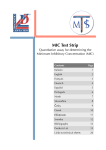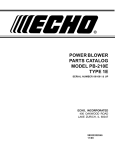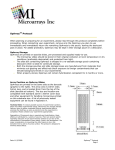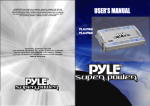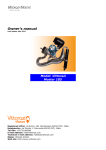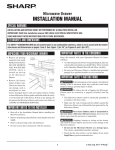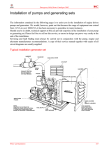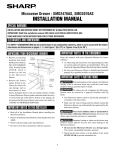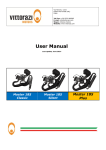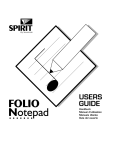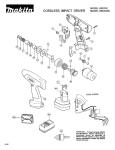Download MT Service Manual
Transcript
E C I L V A R U E E S AN RANG RS M T/MTS OMOTO V M 3 R E E U S ISS F O WARNING Servomotors contain magnetic material which will attract metal particles. Care should be taken when dismantling motors to avoid this. All D.C. servomotors manufactured by SEM contain magnets which are air stable and can be dismantled without demagnetisation MT22 servicing instructions Before commencing any dismantling it is important to mark the following relationships with either a marker pen or some similar method. a) Commutator end housing to motor body (A to B). b) Drive end cover to motor body (C to D). It is advisable to have a suitable stand available to enable the motor to be handled in a convenient manner to minimise the risk of causing damage to any components. DISMANTLING THE MOTOR 1. Remove the brush holder caps (26) and remove the motor brushes (24), marking both the motor brush and brush holder to ensure that each brush can be refitted the right way around in its original holder. Remove cast cover (17), remove encoder adaptor when fitted, take care whilst dismantling not to damage the ‘O’ rings, encoder and encoder adaptor (when fitted). REMOVAL OF TACHO ASSEMBLY 2. Mark position of tacho brush gear assembly to retain the relationship with tacho body assembly (12) for re-assembly. Clamp drive shaft in mole grips or a bench vice (shaft must be suitably protected against any damage during this operation) and remove tacho retaining nut and washer (special tool is required, available from SEM LTD on request). Remove tacho brush gear assembly taking care to remove tacho brushes out of the holders as they are not independently retained. Remove tacho armature, tacho body and spacer sleeve and store in a safe place. Unclamp drive shaft. (b) MOTORS WITH BRAKES Assemble wave washer and bearing to drive end cover and re-fit brake assembly. Position drive end cover over drive shaft and rest on fixing studs (31). Reconnect brake leads, keeping leads well away from any moving parts. Reposition drive end cover over fixing studs and press drive end cover onto armature using a suitable fixture. Assemble tachogenerator to motor and lock in position with nut and washer (15 & 16). (c) When refitting tacho brush gear assembly ensure that spring tensions are correct, as the tension is slackened when tacho brushes are removed from their holders. To avoid this occurring the brushes can be individually captured in their holders by pushing the tacho brush into the holder and fitting a pin in the holes provided on the front of brush holder. This can be done during the dismantling procedure to avoid re-tensioning the brush spring. 6. In the event of the main armature being changed, the neutral setting on the motor must be checked. This can be achieved by applying an appropriate DC voltage (the applied voltage is dependent upon the maximum voltage listed on the nameplate) to motor leads and checking that the speed in both directions are within 30 revs per 1,000 rpm for same applied volts. To increase speed, loosen the two Nyloc nuts (22) and move body assembly in the direction of rotation, relative to the commutator end cover. To decrease speed move body assembly in the opposite direction. After setting neutral position, torque the Nyloc nuts to 4.75Nm (31⁄2 lbs ft). 7. Check tacho assembly for correct voltage output and ripple using a DC volt meter and oscilloscope. To do this motor must be run at 1,000 rpm. If tacho ripple is out of spec (1%), check that the brush spring is located on the slot provided on tacho brush and that the brushes are making contact with the commutator. 8. After test fit new Oilseal, Encoders, Adaptors (when fitted) and Cast cover, refitting ‘O’ rings. 9. Check insulation resistance to earth with a 500 Volt DC megger meter (the minimum resistance acceptable is 3 mega ohms) for the following: - Motor Armature - Tacho Assembly 3. Remove fixing nuts and washers (22) from drive end cover (see note for motors fitted with a brake) and remove drive end cover and motor body assembly. Using a suitable fixture, press out motor armature. Care must be taken not to damage the threaded shaft end. Remove circlip holding comm end bearing so that bearing can be replaced during reassembly Remove oilseal from drive end cover and discard (oilseal must be replaced after motor is reassembled). Note: To dismantle brake motors it is necessary after removing fixing nuts in drive end cover to separate the drive end cover from body assembly by approx. 25mm (1") and disconnect the joints in the brake leads. Using a suitable fixture press out motor armature from comm end cover (take care not to damage the threaded shaft end) and remove motor body. The drive end cover and brake assembly can now be removed. The brake must be removed from drive end cover to change the drive end bearing. RE-ASSEMBLY OF MOTOR 4. Bearings and oilseal must be replaced. Examine brushes for wear and refit or replace if necessary. Care must be taken that no metal particles have been attracted to any magnetised parts. 5. (a) When using existing armature ensure that all markings are in line during assembly. Fit bearing and circlip to commutator end cover, press drive end bearing onto armature and using a suitable fixture, press comm end cover onto armature. Re-fit body assembly and drive end cover refitting wave washer at the drive end. Refit the ‘O’ rings between body assembly and both covers. SEM Limited, Faraday Way, Orpington, Kent BR5 3QT England Telephone: +44 (0) 1689 884700 • Fax: +44 (0) 1689 884884 E-mail: [email protected] • Internet: http://www.sem.co.uk Note. A new Radio Energie Tacho has been fitted to the MT22 since August 2000. Please see final sheet for details Motor Armature Assembly Bearing (Drive End) Circlip (Drive End) Bearing (Commutator End) Wave Washer Drive End Cover Body Assembly Commutator End Cover Assembly Tacho Body Assembly* Tacho Armatures* Tacho Brush Gear Assembly* Tacho Retaining Washer Tacho Retaining Nut Cast Cover (Tacho/Encoder) Cable Gland Fixing Stud Nut Motor Brush Brush Holder Cap Brush Holder Cap Cover Encoder Drive Pin (Optional) Brush Holder Fixing Screw Brush Holder Fixing Stud Spacer Sleeve (Tacho) Tacho Brush Oilseal Brake (Optional) Bearing Retainer Cap (Commutator End) Cast Cover Screws Encoder Adaptor Fixing Screws (Options Encoder Adaptor (Optional) ‘O’ Rings (Mating Face) ‘O’ Rings (Brush Holder) 1 2 3 5 7 8 10 11 12 13 14 15 16 17 18 22 24 25 26 28 29 30 31 33 35 36 37 39 41 42 43 44 45 *For spares complete unit has to be purchased. DESCRIPTION ITEM No. MT22 parts list MT / MTS30 servicing instructions Before commencing any dismantling it is important to mark the following relationships with either a marker pen or some similar method. a) Commutator end housing to motor body (A to B). b) Drive end cover to motor body (C to D). DISMANTLING THE MOTOR 1. Removing the motor brushes (24), seals (25) and caps (26) marking both the carbon brushes and brush holders to ensure that the brushes can be refitted in the correct holders and the correct way around. 2. Remove either the pressed steel or cast cover secured by 4 screws (in some case as encoders and adaptors are fitted these must also be removed). Important: The tacho brush gear (15) and comm. end housing (11) must be marked to retain relationship for re-assembly, again use a scribe or marker pen. Disconnect the tacho leads from terminal block (when fitted). Now remove the 24mm screws and washers (40) from tacho brush gear and take out brush gear complete. (Taking care not to damage tacho brushes) . 3. Remove circlip (4) from front of tacho armature (13) and unscrew tacho sleeve locking set screws (14) located just in front of the commutator. 4. Take out tacho armature noting the number and position of any shim washers both in front and behind the tacho armature sleeve. To assist with the removal of the tacho armature, leverage can be applied behind the set screws or directly into the tapped sleeve holes. Ensure that the set screws have been removed completely or have been slackened off sufficiently to clear groove in shaft. Note:- No shims or circlips were used to locate the tacho armature on motors produced prior May 1984. 5. Remove the oil seal (when fitted) from the drive end cover. (The oil seal must always be replaced with a new one when reassembling). Remove 4-5mm Nyloc nuts (22) from the counter bored holes in the drive end cover. See note 8 for brake motors. 6. Body (10) and drive end cover (8) can now be separated from the commutator end housing (11) and main armature (1). The drive end cover is pinned to the body using roll pin (9). TAKE CARE. Note:- Pre May 1984 motors produced for Bridgeport had the drive end bearing bonded into the drive end cover. 7. To separate the main armature from the commutator end cover entails the removal of 2-4mm screws and washers (39) locking the commutator end bearing to the cover. This operation is carried out using a right angled screwdriver or in case of difficulty the armature can be pressed out through the bearing affording easy access to the screws. Ensure tacho pin (33) is removed with a pair of pliers before pushing out armature. (Prior to May 1984, the commutator end bearing was not locked, the thrust washer being fitted at that end.) RE-ASSEMBLY OF MOTOR 9. Bearings must be replaced whilst brushes can be examined for wear and replaced if required. Refit Wave Washer (7). Care must also be taken to ensure no metal particles have been attracted to any magnetised parts. Important: When pressing on bearings, pressure must only be applied to the inner race (ring). 10. To reassemble motors using existing armature ensure that all markings made under note (1) are in line. Note that the wave washers are at the drive end in all motors manufactured after May 1984. Ensure before assembly that the tacho armature drive pin (33) has been refitted to the main armature shaft. (Bridgeport motors without locked commutator bearings must have the drive end bearing bonded into the drive end cover ) When refitting pre May 1984 tachos, i.e. no circlip or shims, the armature is put on to the shaft without the set screws being tightened The tacho brush gear is then fitted and the tacho armature is set along the shaft until the brushes are approximately 0.25mm from the front edge of the commutator The two set screws should then be tightened ensuring that the screw marked by a file mark or red point on the sleeve is tightened first. 11. In the event of the main armature being renewed the neutral setting of the machine must be checked. This is carried out by applying a known DC voltage to terminals or leads A1 and A2, say 50 or 60 volts and checking that the same speed is obtained in both directions for the same applied voltage. To increase speed loosen the four Nyloc nuts in the drive end cover and move the motor body in the direction of rotation relative to the commutator end cover. To decrease speed move body opposite to direction of rotation. Maximum speed deviation between the two speeds in opposite directions should be in the order of 30 revolutions per 1000 R.P.M. After setting the neutral torque the Nyloc nuts to 4.75Nm (31⁄2 lbs.ft.). 12. Tacho adjustment is most critical and necessary in all cases. If the tacho armature is replaced re-setting of the tacho brush rocker assembly is necessary. To do this, the motor is run at 1000 R.P.M. with a DC Voltmeter and oscilloscope connected to tacho brush gear leads T1 and T2, with a 0.1 mfd capacitor across T1 and T2. The oscilloscope is set to AC input, volts/division set to 0.1 and time base seconds/division closed right down to say 0.2 or 0.5 seconds. Check that when the machine runs clockwise T1 is positive. The tacho brush gear must be adjusted, by rotation, to give a minimum ripple voltage height reading in both directions of rotation. This height should not be greater than 2 x tacho output volts x 0.01. The height reading with the scope closed down includes all irregularities such as modulation and spikes. By opening up the time base to say 5 milli-seconds the actual shape of the output can be studied and any faults identified. Spiking or mushiness could indicate that the commutator requires cleaning. Open circuits will show as a very large irregular pulse with a break in the continuity of trace, whilst short circuits will show as large ‘spiking’ pulses. Run motor at maximum speed (see nameplate) to ensure that spiking does not occur in either direction. If this does occur clean tacho commutator. Ensure that the brush gear is secured. 13. Check insulation resistance to earth with a 500 Volt DC Megger meter. The minimum resistance acceptable is 3 MΩ for the following: - Motor Armature - Tacho Armature - Thermal overload. At the same time, check that the thermal overload is closed. 8. To dismantle brake motors it is necessary, after removing the four Nyloc nuts in the drive end cover, to remove any *circlip and shims from in front of the drive end bearing. Separate the drive end cover from the body by approx 40mm (11⁄2") and unsolder or disconnect the joints made in the brake leads. The drive end cover, brake and bearing assembly can now be removed. (Prior to May 1984 motors with integral brake had the drive end bearing locked between the brake and cover on the outside diameter and between a shaft spacer and circlip on the shaft. On this style of motor if the cover, brake and bearing assembly fail to separate from the main armature the armature can be pressed out. *Circlip not fitted to press fit bearing SEM Limited, Faraday Way, Orpington, Kent BR5 3QT England Telephone: +44 (0) 1689 884700 • Fax: +44 (0) 1689 884884 E-mail: [email protected] • Internet: http://www.sem.co.uk Note. A new Radio Energie Tacho has been fitted to the MT30 / MTS30 since August 2000. Please see final sheet for details ITEM 1 2 3 4 5 6 7 8 9 10 11 12 13 14 15 16 17 18 19 20 21 22 23 24 25 26 27 28 29 30 31 32 33 34 35 36 37 38 39 40 DESCRIPTION Armature Assembly Bearing (Drive End) Circlip Drive End Tachogenerator Circlip Bearing (Commutator End) Circlip Commutator End Wave Washer Drive End Cover Spring Dowel (D.E. Cover Location) Body Assembly Commutator End Cover Assembly Tachogenerator Body Assembly Tachogenerator Armature Assembly Tacho Armature Retaining Screw Tachogenerator Brush Gear Assembly Cover Plate Gasket Cover Plate Terminal Box Terminal Box Gasket Terminal Box Lid Terminal Box Lid Gasket Fixing Stud Nut/Sealoc Washer Terminal Block Motor Brush Insert Brush-Holder Cap & Disc Earth Screw Encoder Drive Pin Brush-Holder Fixing Screw Brush-Holder Fixing Stud Terminal Box Fixing Screw Tachogenerator Drive Pin Tachogenerator Body Fixing Screw Tachogenerator Brush Oilseal (Optional) Brake (Optional) Thermal Overload Washer, Bearing Retainer Tachogenerator Brush Gear Fixing Screws MT30 parts list MT40 servicing instructions The MT40 Servomotor is a locked drive end bearing motor with the tacho armature located and locked in position on the shaft by two set screws. Before commencing any dismantling it is important to mark the following relationships with either a marker pen or some similar method. 1. (a) Commutator end housing to motor body (A to B). (b) Drive end cover to motor body (C to D). DISMANTLING THE MOTOR 2. Remove the motor brushes (24), seals (25) and caps (26) marking both the carbon brushes and brush holders to ensure that the brushes can be refitted in the correct holders and the correct way around. 3. Disconnect the tacho leads from the terminal block (23), when fitted, and remove either the pressed steel or cast cover (17), secured by 4 screws (in some cases an encoder and adaptor are fitted and these must also be removed). Important. The tacho brush gear and the commutator housing must be marked to retain relationship for reassembly. Again use scribe or marker pen. Now remove the 2-4mm screws and washers (40) from the tacho brush gear and take out brush gear complete. (On earlier model motors the tacho brush gear and tacho body were secured by two protruding studs with nuts and washers clumping the two parts to the commutator end cover ) 4. Unscrew the two tacho sleeve set screws (14) located just in front of the commutator, and remove tacho armature. To assist with the removal of the tacho armature, leverage can be applied behind the set screws or directly into the tapped sleeve holes (with set screws removed) ensuring that either the set screws have been removed completely or have been slackened off sufficiently to clear the groove in the shaft. 5. Remove the oil seal (when fitted) from the drive end cover The oil seal must always be replaced with a new one when reassembling. Remove circlip and shim washers used to lock drive end bearing axially on the shaft Remove 4-6mm Nyloc nuts (22) from the counterbored holes in the drive end cover 6. Using a rubber or hide mallet separate commutator end housing (11) from the motor body assembly (10), and remove commutator end housing (See note 7 for brake motors). Separate and remove body assembly (10) from drive end cover (8). The drive end cover is pinned to the body assembly using roll pins. Take care. Press or tap off drive end covers and bearing from armature assembly (1). Remove circlip, shims and bearing from drive end cover and take out tacho drive pin (33) and remove commutator end bearing (5). 7. To dismantle brake motors after removing the Nyloc nuts (22) separate commutator end housing (11) from body assembly (10) as far as brake leads slack allow. Using rubber or hide mallet tap drive end cover to allow for leverage of body assembly. Lever body assembly to form a gap of 60mm (21⁄2") and fit spacers to hold in position. Disconnect or unsolder joints in brake leads. Remove commutator end housing and body assembly then press or tap off drive end cover and brake assembly. (Care to be taken not to damage the brake). Remove brake assembly from drive end cover (secured to cover by 6 screws in the front face of cover) to change drive end bearing. RE-ASSEMBLY OF MOTOR 8. Bearings and oil seals must be replaced whilst brushes can be examined for wear and replaced if required. Refit wave washer at the commutator end. Care must also be taken to ensure no metal particles have been attracted to any magnetised parts. Important: When pressing on bearings, pressure must only be applied to the inner race (ring). 9. To reassemble motor using the existing armature ensure that all markings made under notes (a) and (b) are in line. Ensure before assembly that the tacho armature drive pin has been refitted to the main armature shaft. The drive end bearing is located in the drive end cover, shimmed to eliminate axial movement and locked by an internal circlip (4) in the end cover bore. Press drive end cover assembly and comm. end bearing (5) onto armature (1) shaft. It is necessary after assembling the drive end cover to shim out the axial end play by fitting shims between bearing and circlips (3). Refit body assembly and commutator end housing, using an old tacho armature or bung located in the tacho body assembly (12) to centralise the armature during the assembly. On brake motors, a spacer must be used to separate the body assembly and drive end cover by 60mm (21⁄2"). Refit commutator end housing (see note regarding centralising the armature) and reconnect or solder brake lead joints. Take care to insulate the joints and that the leads are tucked well away from any moving parts. To assist when fitting brake and end cover assembly on to brake hub, a voltage should be applied to brake leads (see motor nameplate for correct Voltage). 10. When refitting the tacho armature, the armature is put onto the shaft without the set screws being tightened. The tacho brush gear is then fitted and the tacho armature is set along the shaft until the brushes are approximately 0.25mm from the front edge of the commutator. The two set screws should then be tightened ensuring that the screw marked by a file mark/red paint on the sleeve is tightened first. Ensure that the brush gear is lined up (as note 3). 11. In the event of the main armature being renewed the neutral setting of the machine must be checked. This is carried out by applying a known DC voltage to terminals or leads A1 and A2, say 80 or 90 volts and checking that the same speed is obtained in both directions for the same applied voltage. To increase speed loosen the four Nyloc nuts in the drive end cover (C) and move the motor body in the direction of rotation relative to the commutator end cover. To decrease speed move body opposite to direction of rotation. Maximum speed deviation between the two speeds in opposite directions should be in the order of 30 revolutions per 1000 R.P.M. After setting the neutral, torque the Nyloc nuts (22) to 7.5Nm (51⁄2 Ibs. ft.). 12. Tacho adjustment is most critical and necessary in all cases. If the tacho armature is replaced re-setting of the tacho brush rocker assembly is necessary. To do this, the motor is run at 1000 R.P.M. with a DC Voltmeter and oscilloscope connected to tacho brush gear leads T1 and T2, with a 0.1 mfd capacitor connected across T1 and T2. The oscilloscope is set to AC input, volts/division set to 0.1 and time base seconds/division closed right down to say 0.2 or 0.5 seconds. Check that when the machine runs clockwise T1 is positive. The tacho brush gear must be adjusted, by rotation, to give a minimum ripple voltage height reading in both directions of rotation. This height should not be greater than 2 x tacho output volts x 0.01. The height reading with the scope closed down includes all irregularities such as modulation and spikes. By opening up the time base to say 5 milliseconds the actual shape of the output can be studied and any faults identified. Spiking or mushiness could indicate that the commutator requires cleaning. Open circuits will show as a very large irregular pulse with a break in the continuity of trace, whilst short circuits will show as very large ‘spiking’ pulses. Run motor at maximum speed (see nameplate) to ensure that spiking does not occur in either direction. If this does occur clean tacho commutator. Ensure that the brush gear is secured. 13. Check insulation resistance to earth with a 500 Volt DC Megger meter. The minimum resistance acceptable is 3 MΩ for the following: - Motor Armature - Tacho Armature - Thermal overload. At the same time, check that the thermal overload is closed. SEM Limited, Faraday Way, Orpington, Kent BR5 3QT England Telephone: +44 (0) 1689 884700 • Fax: +44 (0) 1689 884884 E-mail: [email protected] • Internet: http://www.sem.co.uk ITEM No. 1 2 3 4 5 6 7 8 9 10 11 12 13 14 15 16 17 18 19 20 21 22 23 24 25 26 27 28 29 30 31 32 33 34 35 36 37 38 40 41 DESCRIPTION Armature Assembly Bearing (Drive End) Circlip Drive End Circlip Drive End Bearing (Commutator End) Circlip Commutator End Wave Washer Drive End Cover Spring Dowel (D.E. Cover Locution) Body Assembly Commutator End Cover Assembly Tachogenerator Body Assembly Tachogenerator Armature Assembly Tacho Armature Retaining Screw Tachogenerator Brush Gear Assembly Cover Plate Gasket Cover Plate Terminal Box Terminal Box Gasket Terminal Box Lid Terminal Box Lid Gasket Fixing Stud Nut/Sealoc Washer Terminal Block Motor Brush Insert Brush-Holder Cap & Disc Earth Screw Encoder Drive Pin Brush-Holder Fixing Screw Brush-Holder Fixing Stud Terminal Box Fixing Screw Tachogenerator Drive Pin Tachogenerator Body Fixing Screw Tachogenerator Brush Oilseal (Optional) Brake (Optional) Thermal Overload Tachogenerator Brush Gear Fixing Screws ‘O’ Ring MT40 parts list MT52 servicing instructions The ‘52’ series servomotors is a locked drive end bearing motor, with the tachogenerator armature located and locked in position on the armature shaft by two set screws. Due to the physical size and weight of the motors; it is advisable to have a suitable stand to enable the motors to be handled in a convenient manner. This will also help to minimise the risk of damage during dismantling and re-assembly. 1. Before commencing any dismantling it is important to mark the following relationships with either a marker pen or some similar method. a) Commutator end housing to motor body (A to B). b) Drive end cover to motor body (C to D). DISMANTLING THE MOTOR 2. Remove caps (26), seals (25) and brushes (24) marking both the carbon brushes and brush holders to ensure that the brushes can be refitted in the correct holders and correct way around. 3. Disconnect the tacho leads from terminal block (23) when fitted. Remove the steel covers or encoder and adaptor plate assembly secured by 4 screws to end of commutator end housing. IMPORTANT: The Tacho brush gear and commutator end housing must be marked to retain relationship for reassembly Again use a marker pen or scribe. Now remove the two 4mm screws and washers securing the tacho brush gear assembly and take out brush gear complete, taking care not to damage the tacho brushes. 4. Unscrew the two tacho set screws (14) located in front of the commutator and remove the tacho armature. (To assist in the removal, leverage can be applied behind the set screws or directly into the tapped holes wish set screws removed). Ensuring that the set screws are either removed completely or slackened sufficiently to clear the groove in the shaft. 5. Position motor vertically on drive end cover on a suitable stand. Remove the 4 Nyloc nuts (22) and flat ended washers from the radial slots in commutator end housing. Disconnect the brake leads from terminal block (23) when brake fitted. Remove the commutator end housing taking care not to lose the wave washer (7) from the non drive bearing housing. 6. With a suitable stand to support the body and armature assembly in a horizontal position using a rubber or hide mallet ease the drive end cover off the locating pins (9). Relocate the motor in the vertical position and remove body assembly (care to be taken not to trap hands or fingers when removing body assembly due to the magnetic pull between components). 7. Supporting armature in a horizontal position. (a) On non brake motors remove the three screws (41) holding the inside end cap (39) and remove the drive end cover. Remove circlip (3) and remove bearings. (b) On brake motors remove the six screws holding the brake (37) to the drive end covers and disconnect the brake leads and remove the drive end cover. RE-ASSEMBLY OF MOTORS 8. Bearings and oilseals (when fitted) must be replaced, whilst brushes can be examined for wear and replaced if required. Care to be taken that no metal particles have been attracted to any magnetised parts. IMPORTANT: When pressing on bearings, pressure must only be applied to the inner race (ring). 9. (a) With the bearing locking cap (39) in position at the drive end press bearings onto armature shaft. Refit circlip (3) and tacho drive pin (33). Assemble drive end cover (8) to armature lining up locking cap holes wish drive end cover holes by using a short stud and refit the three screws (45). Stand the assembly vertically with drive end shaft down. Slide body assembly (10) over the armature (take care of magnetic pull, see note 6) and locate on drive end cover ensuring the correct alignment. Stand the assembly vertically, with drive end shaft down. Refit commutator end cover over the fixing studs (31) ensuring that the wave washer (7) is in position and fit to motor body, taking care to align markings as in operation 1. Lock commutator end cover with flat sided washer and fixing stud nuts (22). b) On brake motors. Assemble brake to armature and press on bearings. Refit circlip and tacho drive pin. Refit drive end cover to armature, locate brake in original position, refit the four screws and secure to drive end cover. Reconnect brake leads, insulate joint and keep any slack away from the armature. Refit body assembly and commutator end cover as in operation (a) ensuring that the brake leads are passed through into the terminal box whilst assembling the comm end cover. 10. Refit motor brushes, sealing discs and caps. Assemble tacho armature and locate on drive pin (33), refit tacho brush gear to tacho body (12) passing leads through into terminal box, align with markings and secure tacho brush gear. Adjust position of tacho armature so that brushes are approximately 0.10mm for the front edge and lock set screws, tightening up screw marked with red paint or a file mark on tacho sleeve and then tighten up the apposition screw. CHECK SPEED, CURRENT AND TACHO RIPPLE 11. (a) Apply 90 Volts DC to terminals A1 & A2 with A2 supplied positive the motor should run anti-clockwise. Check speed and current. (b) Reverse motor (i.e. A1 positive). Check speed and current at 90 Volts DC. If the two speeds are within 20 revolutions per 1,000 then the neutral setting is acceptable. If not, to alter speed loosen off nuts (22) and move commutator end cover away from the direction of rotation to decrease speed. After setting the speed tighten down the nuts (6) to 13.5Nm (10lbs. ft.). TACHO ADJUSTMENT 12. Tacho adjustment is most critical and necessary in all cases. If the tacho armature is replaced resetting of the tacho brush rocker assembly is necessary. To do this, the motor is run at 1,000 rpm with a DC voltmeter and oscilloscope connected to the tacho brushgear leads T1 & T2 with a 0.1 mfd capacitor connected across the tacho leads. The oscilloscope is set to AC input, volt/division set to 0.1 and time base set to say 0.2 or 0.5 seconds. Check that when the machine runs clockwise T1 is positive. The tacho brushgear must be adjusted, by rotation. To give a minimum ripple voltage height in both directions of rotation. This height should not be greater than 2 x tacho output volts x 0.01. The height reading with the scope closed down includes all irregularities such as modulation and spikes. By opening up the time base to say 5 milliseconds the actual shape of the output can be studied and any faults identified. Spiking or mushiness could indicate that the commutator requires cleaning. Open circuits will show as a very large irregular pulse with a break in the continuity of trace, while short circuits will show large ‘spiking’ pulses. Run motor at maximum speed (see nameplate) to ensure that spiking does not occur in either direction. If this does occur, clean tacho commutator. Ensure that the tacho brushgear is secure. 13. Check insulation resistance to earth with a 500V DC megger meter. The minimum resistance acceptable is 3MΩ for the following: - Motor Armature - Tacho Armature - Thermal Overload At the same time check that overload is closed. 14. Refit steel cover and dowel pins. Seal bearing locking cap screws and dowel pin with sealant – fit oilseal if required. SEM Limited, Faraday Way, Orpington, Kent BR5 3QT England Telephone: +44 (0) 1689 884700 • Fax: +44 (0) 1689 884884 E-mail: [email protected] • Internet: http://www.sem.co.uk ITEM No. 1 2 3 5 7 8 9 10 11 12 13 14 15 16 17 18 19 20 21 22 23 24 25 26 27 28 29 30 31 32 33 34 35 36 37 38 39 40 41 42 43 44 45 DESCRIPTION Motor Armature Bearing Drive End Circlip Drive End Bearing Commutator End Wave Washer Drive End Cover Spring Dowel (D.E. Cover Location) Body Assembly Commutator End Cover Assembly Tacho Body Assembly Tacho Armature Assembly Tacho Armature Retaining Screw Tacho Brush Gear Assembly Tacho Cover Plate Gasket Tacho Cover Plate Terminal Box Terminal Box Gasket Terminal Box Lid Terminal Box Lid Gasket Fixing Stud Nut Terminal Block Motor Brush Insert Brush-Holder Cap & Disc Earth Screw Encoder Drive Pin Brush Holder Fixing Screw Brush Holder Fixing Stud Terminal Box Fixing Screws Tacho Drive Pin Tacho Body Fixing Screws Tacho Brush Oilseal (Optional) Brake (Optional) Thermal Overload Bearing Locking Cap Tacho Brush Gear Fixing Screws Blower Plate & Gasket Terminal Block Fixing Strip Terminal Box Base Terminal Box Base Gasket Drive End Bearing Locking Cap Screws MT52 parts list IMPORTANT. CHANGE TO TACHO SPECIFICATION. In order to concentrate our production efforts directly on the production of servomotors we no longer make and fit the SEM tacho to certain products in our range. In place of the SEM tacho we now fit a tacho made by the company Radio Energie. Please note the following changes to motor specifications: MT22 series. The Radio Energie tacho was introduced to this motor series in August 2000. The assembly sequence for the Radio Energie tacho differs slightly from the SEM unit in that the armature is assembled first and then the integral body/brushgear assembly. As an assembly the Radio Energie tacho is directly interchangeable with the SEM unit ,however the individual components and brushes are not. MT30 series. The Radio Energie tacho was introduced to this motor series in August 2001. The Radio Energie tacho is not interchangeable with the SEM unit, however the SEM unit will be made available for spares requirements for some time to come. MTS30 series. The Radio Energie tacho was introduced to this motor series in August 2001. The assembly sequence for the Radio Energie tacho differs slightly from the SEM unit in that the armature is assembled first and then the integral body/brushgear assembly. As an assembly the Radio Energie tacho is directly interchangeable with the SEM unit ,however the individual components and brushes are not. MT40 series. The SEM tacho will continue to be fitted to this series. MT52 and DBMT52 series. The SEM tacho will continue to be fitted to this series. If you require further information regarding the tacho fitted to our brushed servomotor series please contact our Service Dept. WARNING Servomotors contain magnetic material which will attract metal particles. Care should be taken when dismantling motors to avoid this. All D.C. servomotors manufactured by SEM contain magnets which are air stable and can be dismantled without demagnetisation SEM Limited, Faraday Way, Orpington, Kent BR5 3QT England Telephone: +44 (0) 1689 884700 Fax: +44 (0) 1689 884884 E-mail: [email protected] Internet: http://www.sem.co.uk UL VERSIONS AVAILABLE










